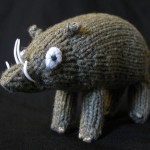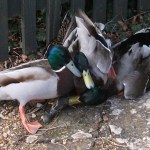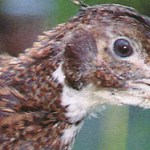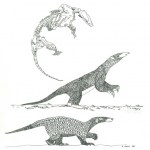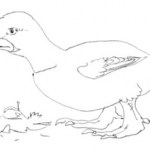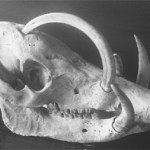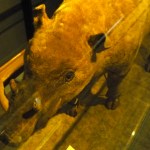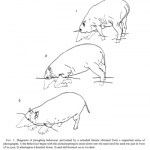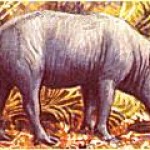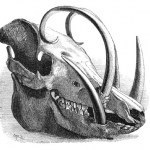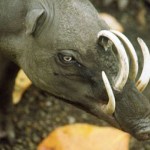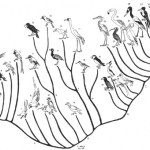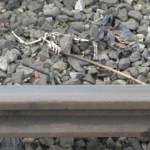I like to think that I've done my bit for babirusa promotion. Hopefully you agree. And babirusas could do with lots of promotion - not only are they fascinating and bizarre, they're globally endangered and in real need of protection (if you want to know more, check out Babirusa.org).
I'm pleased to announce that my babirusa articles here at Tet Zoo have not only inspired an endearing cartoon, but something equally fantastic and captivating... a knitted babirusa!
Sasha Kopf - or Tapir Girl, if you prefer - mostly knits tapirs (as you can see from her collection of photos here). She's…

Tyrant dinosaurs - properly called tyrannosauroids - are most usually associated with the Late Cretaceous of North America. Of course, if you know anything about dinosaurs you'll also know that many tyrants were Asian. So, the most familiar tyrants - the big, short-armed kinds like Tyrannosaurus, Tarbosaurus, Albertosaurus and Daspletosaurus (all of which belong to the best-known tyrant clade, Tyrannosauridae) - were all animals of Laurasia, the northern landmass that split up during the Cretaceous to form North America and Eurasia [image above provided by Roger Benson; read on for…
Ducks - like the Mallards Anas platyrhynchos shown here - lead fairly violent sex lives. As I said in a previous article...
[A]s you'll know if you've spent any time watching ducks, 'forced extra-pair copulations' are very common in ducks. The Mallard Anas platyrhynchos is the best (or should that be worst?) example of the lot: females are handled so roughly by males (sometimes by groups of as many as 12) that it's quite common for people to speak of witnessing 'duck rape', and forced copulation is a common strategy used by males of this species.
Over the weekend I was fortunate enough to be…
A lot of zoos have very neat murals and other works of art. Over the weekend we visited Marwell here in Hampshire: it's our 'local' zoo and we go there a lot. I really like the 'march of the penguins' feature they have on the outside of the penguin pool. Here's Will, looking at each penguin species in turn...
While I've photographed this feature a few times before (I previously featured it here), this time round I did something new: I photographed each penguin figure individually. Here they are, squashed into a montage that destroys the sense of correct scaling present in the original.
Are…
Captive pheasants Phasianus colchicus frequently practise cannibalism: this isn't necessarily as gruesome as it sounds, but mostly consists of repetitive pecking or picking that opens wounds or results in the removal of toes. In chicks, toe and beak picking are common, while vent, wing and head picking more frequently occurs in older birds. Open, bleeding wounds (when visible) cause the birds to attack again, and they will keep attacking until the victim is fatally injured or killed. All gamebirds practise this sort of behaviour in captivity, but pheasants are by far the worst.
'Outbreaks'…
As some of you might know, all of my 'free' time last month was eaten up by a major project (a book chapter) that had a very tight deadline. This meant no time whatsoever for such stuff as blog-writing, hence the (mostly) recycled babirusa stuff. That project is now (mostly!) complete, but I'm still struggling for time due to other projects and jobs. Meanwhile, I thought I'd recycle this...
The illustration was previously used here, back on ver 1 in 2006, and again here in a ver 2 article on ameghinornithids. Eurotamandua joresi, shown at top as a skeleton and in the middle as a life…
It turns out that Martinus van Tee of Caricature a day (and of martinus van tee illustration) is a big fan of Tet Zoo, and obviously of babirusas too. Yes, here's me, Flintstone-style, riding a familiar artiodactyl. Have I written about babirusas on Tet Zoo? - - I can't remember.
Thanks indeed Martinus, truly I am honoured. In real life, remember that babirusas need help: they are threatened by illegal hunting and habitat destruction on Sulawesi (visit Babirusa.Org for more).
Waterfowl (or wildfowl, or anseriforms, or ducks, geese, swans and kin) are awesome. Last year saw the publication of a particularly freakish, recently extinct member of the group that's been known to some of us for a while: the surreal Hawaiian duck Talpanas lippa Olson & James, 2009 from Kauai*. I'll admit that I missed the memo (didn't know about publication until Glyn Young sent me a pdf), even though Chris Taylor at Catalogue of Organisms wrote about Talpanas on its publication.
* Note that Talpanas joins that very annoying list of names where the authorship of the taxon [Olson…
Even in this day and age - when anyone who's anyone has a huge personal pdf archive - 'dead tree' libraries are still used by many (or most?) of us.
Partly because I've never worked on a computer that can do more than three things at once, partly because I spend 90% of my waking life staring at screens anyway, and partly because I really prefer to hold literature in my hands and have it scattered about the desk while writing, I hate using pdfs and will always use hard-copy when possible. I even find myself wasting time hunting down a printed-out copy of a paper when I know full well that a…
Yeah, things are still tough here at Tet Zoo Towers, and the time needed for blog-writing has yet to materialise. But the end is in sight, and things will be back to normal within the next few weeks. I hope.
If you've been reading the series of babirusa articles - and, hey, who hasn't? - you'll recall the mention of that most sought-after of objects: a male babirusa skull where one of the upper canines has pierced the frontal bone, and grown into the skull... perhaps with fatal consequences. Given the extraordinary form of the canines, it seems obvious and perhaps inevitable that at least…
In the previous article we looked at the proposal that the various babirusa taxa - long regarded as subspecies - deserve to be raised to species rank. The argument goes that the taxa concerned are (1) morphologically diagnosable, (2) 'as distinct' as are other taxa traditionally regarded as species (raising the taxa to species level therefore represents a sort of attempt at uniformitarianism), and (3) represent distinct phylogenetic lineages. Meijaard & Groves's proposal therefore reflects their adherance to the phylogenetic species concept, or PSC (where distinct lineages on a…
Welcome to yet another article in the (outstandingly successful, yet recycled from ver 1) series on babirusas. Observant readers will have noticed that, strangely, I've refrained thus far from using a scientific binomial for babirusas, plus I've consistently (I think) referred to them in the plural, and not as a single species. What gives?
Well, the proverbial cat is already out of the bag, but the traditional taxonomy where all babirusas are referred to the single species Babyrousa babyrussa is now defunct and there are good reasons for recognising several species. Babirusa taxonomy was…
The bipedal 'boxing' behaviour of babirusas is odd, but arguably odder is a unique sort of 'ploughing' behaviour they've recently been shown to practise. On being presented with an area of soft sand, captive babirusas (mostly males) have been noted to kneel down and push their head and chest forward through the sand, the result being a deep furrow. One obscure report from the 1970s suggests that Sulawesi people associated babirusas with the creation of straight-line furrows. Possible babirusa furrows were reported from south-eastern Sulawesi in 2002, but this behaviour has otherwise gone…
In the previous articles we looked at the distribution and phylogenetic position of babirusas, and also at a bit of their behaviour, biology and morphology. While babirusas are famous for the bizarre upper canines that emerge from the dorsal surface of the snout in males, the function of these teeth remains uncertain. As we saw in the previous article, it's been proposed that they function in display, in fighting, or in helping the animal to push its way through dense vegetation. The latter idea is least likely and is unsupported by observations. The fighting idea might seem logical and…
Another article on babirusas - yaay! Like many (but not all) pigs, babirusas are omnivorous, and are said to eat invertebrates whenever they find them. They have also been reported to eat fish on occasion, to catch small mammals, and even to catch and eat the juveniles of other babirusas (Leus & Morgan 1995). They eat all kinds of plant material, including fruits, leaves, flowers, berries, nuts, bark and tubers, and they not only browse and dig to obtain such items, they are also surprisingly good at standing bipedally (without support) to feed on leaves. This again is a curious parallel…
More on babirusas! Go here for part I.
While babirusas look pig-like and are classified as part of Suidae, they're distinctive and unusual [image above from wikipedia]. Combining rather slender legs with a barrel-shaped body, they can exceed 1 m in length and have a shoulder height of 65-80 cm. Some individuals weigh as much as 100 kg. Babirusas are odd in having particularly remarkable canines (more about those soon), but less well known is that they differ from other pigs in several details of their anatomy, and in fact resemble peccaries and other artiodactyls in a few features. The…
In the interests of recycling old material from Tet Zoo ver 1, I present... yes, a whole series of articles devoted to one of the most unusual and remarkable of hoofed mammals. Come on, we all love babirusas. If you've been with Tet Zoo from the beginning, none of what's to follow will be new [adjacent photo from here]. For the rest of you: buckle up and enjoy the ride...
You might be surprised to learn that babirusas have been known to westerners for a comparatively long time, having been named Sus babyrussa by Linnaeus in 1758 (the generic name Babyrousa was first coined by Perry in 1811…
Well, I really was very much enthused, inspired and uplifted by the many kind and supportive comments so many of you added to the previous article. Thank you all. So enthused, in fact, that I couldn't help myself, and took time out of lunch breaks and so on to produce 'ticking over' material for Tet Zoo.
As some of you know, I'm hard at work on a major project concerning birds at the moment (and, to the people who made speculations that such project might be lucrative... let me assure you that none of the science writing I do can be described as 'lucrative' - no money is involved in this…
Every now and then, financial woes and other problems mean that I go through a major period of apathy and self-deprecation. And, after four years of very successful operation, I have seriously been considering calling it quits on Tetrapod Zoology. Extreme, heartfelt thanks to the friends and others who have provided help, or have expressed personal concern.
However... just to keep you in the loop... as John Conway said in one of the comments, blogging is like crack addiction: I don't think I could give it up even if it really were in my interests to do so (and some people do argue that it's…
I have to take a break. I may be gone for some time... I may not. Here are some cool photos.
